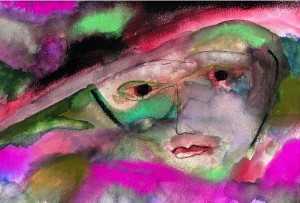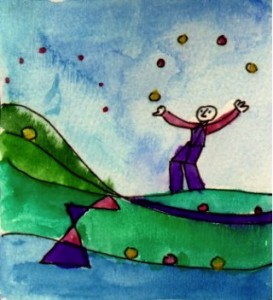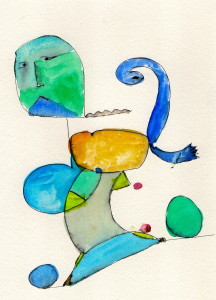New interesting mind/brain science news ( 2014)
Switching off the eating/appetite button in the brain
(This news item will be moved to the project and post on the neuroscience of dieting) A light signal delivered to some nerve cells can get mice to suddenly lose interest in eating. David Anderson and his colleagues (Cal Tech neuroscientists) accidentally discovered that a small cluster of neurons in the brains of mice are central players in controlling appetite and eating. These same neurons may also play a similar role in humans. This finding clearly requires further attention and obviously has also sorts of practical implications for controlling eating, dieting.
Prune the rose bush and then neurons in your brain
Sure. It is a study conducted in mice but it sure makes you sit up and think. It might even prevent you from dropping your pen as you slip into sleep. It turns out that one of the roles of brain microglia is to prune ‘unwanted’ synapses and therefore strengthens the connections of the more useful brain neurons. This is an event that occurs in early mouse development and changes the mouse social behavior. The bottom line is that destroying damaged or weak connections improves the functioning of the rest of the brain. I guess getting rid of garbage is a good thing.
Read more about it in Y. Zhan et al., “Deficient neuron-microglia signaling results in impaired functional brain connectivity and social behavior,” Nature Neuroscience, doi.org:10.1038/nn.3641, 2014.
King Richard the III has been dead for hundreds of years but lives on.
The power and reach of modern genetics continues to amaze. It turns out that Richard the III lay buried beneath a parking lot in Leicester, U.K. What an opportunity to get a close look at who he was by extracting his DNA from his remaining bone fragments. The plans are in the works to also look at the DNA of some of his relatives, which may turn out they, were not as related as they thought they were. Too bad Richard III isn’t around to voice his reaction to the science that is swirling around his remaining bones.
Don’t sell short the ability of very kids to learn some complex concepts.
You might not want to try and teach calculus to 5-8 year old kids. But maybe you might reconsider that. Could young kids learn all about the concept and implications of natural selection? It turns out that if presented with care preschoolers can successfully learn about natural selection. The study published in the 2014 Feb 6 issue of Psychological Science. ( Kelemen, et al. Young Children Can Be Taught Basic Natural Selection Using a Picture-Storybook Intervention) used a storybook method for teaching these young kids basic but theoretically coherent mechanistic explanation of adaptation through natural selection. The authors showed that the kids not only understood the concept but could also apply what they had learned. Maybe we are far too cautious in what we think little kids can learn. Don’t you wish that adults could be as effective as learners?
Transplantation of healthy new brain cells reverses learning and memory loss in Alzheimer’s disease model
Is it possible to reverse the learning memory impairment in Alzheimer’s disease? Perhaps. We are getting closer to that possibility at least in a mouse model of this disease
The foundations of the study started with the well-established finding that apoE4, is the most important genetic risk factor for Alzheimer’s disease. The researchers, improved cognition to normal levels in aged mice by “transplanted inhibitory neuron progenitors—early-stage brain cells that have the capacity to develop into mature inhibitory neurons—into two mouse models of Alzheimer’s disease, apoE4 or apoE4 with accumulation of amyloid beta, another major contributor to Alzheimer’s. The transplants helped to replenish the brain by replacing cells lost due to apoE4, regulating brain activity and improving learning and memory abilities.”
Leslie Tong and colleagues who are at the Univ. of California, San Francisco’s Gladstone Institutes, report the results in the Journal of Neuroscience.
Autism
Autism is much more likely to be inherited than acquired by life events, or the nonsense once touted as the cause, childhood vaccinations. In a study in (July 2014) Nature Genetics by Joseph Buxbaum and colleagues they report “Genetic variation likely accounts for roughly 60 percent of the liability for autism, with common variants comprising the bulk of its genetic architecture. Although each exerts just a tiny effect individually, these common variations in the genetic code add up to substantial impact, taken together.”
Intercourse
Scientists and so many others have always wondered about the mechanisms that are the basis of our experience of huge pleasure while having intercourse. Now, with the marvels of current imaging methods you can get a first hand look at what is happening during intercourse. Just one of their discoveries using imaging methods is that “ when inside the vagina, the penis does not stay straight; it forms a boomerang shape. More surprisingly, in the root of the penis, the portion that lies inside the man’s body cavity, the erection is as long as [in] the pendulous part,” Rather than tell you the story of this science why not watch it. To do that Google The Scientist and search for an article written by Rina Shaikh-Lesko | July 1, 2014.
On being, becoming, gay
In a super provocative interview with our respected and well known NIH scientist you can get an eye opener into the world of the scientific evidence and thoughts about gayness. Please don’t throw stones or do any name calling. It is one scientists view of being gay and I would think that he represents a position that is not tainted by prepredjudisces. The title of the article by Dean Hamer in the July 1 2014 issue of The Scientist and the title of the article is Searching for Gay Genes
Turning on and turning off memories with a light switch
Here are some clever methods can be used to unlock the mysteries of memory and other brain functions. Using optogenetic methods (light-dependent manipulations of the animals’ neurons) researchers were able to alter connections between hippocampal neurons—which encode “where” memories—and amygdala neurons—which code for either positive or negative emotions. See the complete details in the 27 August issue of Nature authored by Susumu Tonegawa and colleagues. In a similar, related, study Roberto Malinow, at University of California, San Diego used light to stimulate key nerve connections in the brains of rats, and were then able to erase certain memories, and then restore them with a second type of light (see the June 1 2014 issue of Nature).
“We can form a memory, erase that memory and we can reactivate it, at will, by applying a stimulus that selectively strengthens or weakens synaptic connections,” study senior researcher Dr. Roberto Malinow, a professor of neurosciences the University of California, San Diego, said in a university press release.
Reporting in the June 1 issue of Nature, Malinow and his colleagues said they removed and reactivated memories in rats by stimulating synapses, which are connections between brain nerve cells (neurons).
Sleep and consolidating memories (research revisited once again)
Once again we can read about the relatiohship between sleep, learning and memory. This is research that keeps repeating itself almost as if all those science reports during the last few decades are not believable. In a recent study in mice findings suggest that that a good night’s sleep helps us lay down memories by promoting the growth of new connections between brain cells and that sleep enhances the consolidation of newly formed memories in people. Researchers discovered that in mice, learning a new task led to the formation of new dendritic spines – tiny structures that project from the end of nerve cells and help pass electric signals from one neuron to another – but only in the mice left to sleep. The published research was conducted by Wenbiao Gan of the Skirball Institute of Biomolecular Medicine at New York University Medical School and his colleagues.
Treating drug addiction by using chemicals that can get you to forget you are addicted
Numerous researchers have pointed out that drug addiction is a form of memory. Given that ‘fact’ it was interesting to note that a group of scientists discovered a new chemical chemical that prevents rats from recalling their drug-associated memories (for more details read an article published by JANALI GUSTAFSON, in the SCIENTIFIC AMERICAN (41, 58, 3)
Switching off the eating/appetite button in the brain
A light signal delivered to some nerve cells can get mice to suddenly lose interest in eating. David Anderson and his colleagues (Cal Tech neuroscientists) accidentally discovered that a small cluster of neurons in the brains of mice are central players in controlling appetite and eating. These same neurons may also play a similar role in humans. This finding clearly requires further attention and obviously has also sorts of practical implications for controlling eating, dieting.
(This news item should be moved to the project and post on the neuroscience of dieting)



